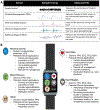Wearable Devices in Cardiovascular Medicine
- PMID: 36862812
- PMCID: PMC9991078
- DOI: 10.1161/CIRCRESAHA.122.322389
Wearable Devices in Cardiovascular Medicine
Abstract
Wearable devices, such as smartwatches and activity trackers, are commonly used by patients in their everyday lives to manage their health and well-being. These devices collect and analyze long-term continuous data on measures of behavioral or physiologic function, which may provide clinicians with a more comprehensive view of a patients' health compared with the traditional sporadic measures captured by office visits and hospitalizations. Wearable devices have a wide range of potential clinical applications ranging from arrhythmia screening of high-risk individuals to remote management of chronic conditions such as heart failure or peripheral artery disease. As the use of wearable devices continues to grow, we must adopt a multifaceted approach with collaboration among all key stakeholders to effectively and safely integrate these technologies into routine clinical practice. In this Review, we summarize the features of wearable devices and associated machine learning techniques. We describe key research studies that illustrate the role of wearable devices in the screening and management of cardiovascular conditions and identify directions for future research. Last, we highlight the challenges that are currently hindering the widespread use of wearable devices in cardiovascular medicine and provide short- and long-term solutions to promote increased use of wearable devices in clinical care.
Keywords: cardiac rehabilitation; cardiology; digital technology; healthy lifestyle; wearable electronic devices.
Figures


References
-
- Goldsack JC, Coravos A, Bakker JP, Bent B, Dowling AV, Fitzer-Attas C, Godfrey A, Godino JG, Gujar N, Izmailova E, et al. Verification, analytical validation, and clinical validation (V3): the foundation of determining fit-for-purpose for Biometric Monitoring Technologies (BioMeTs). NPJ Digit Med. 2020;3:55. - PMC - PubMed
-
- Ferguson T, Olds T, Curtis R, Blake H, Crozier AJ, Dankiw K, Dumuid D, Kasai D, O’Connor E, Virgara R, et al.. Effectiveness of wearable activity trackers to increase physical activity and improve health: a systematic review of systematic reviews and meta-analyses. Lancet Digit Health. 2022;4:e615–e626. - PubMed
-
- Leclercq C, Witt H, Hindricks G, Katra RP, Albert D, Belliger A, Cowie MR, Deneke T, Friedman P, Haschemi M, et al. Wearables, telemedicine, and artificial intelligence in arrhythmias and heart failure: Proceedings of the European Society of Cardiology: Cardiovascular Round Table. Europace. 2022. - PubMed
Publication types
MeSH terms
Substances
Grants and funding
LinkOut - more resources
Full Text Sources
Medical
Research Materials

